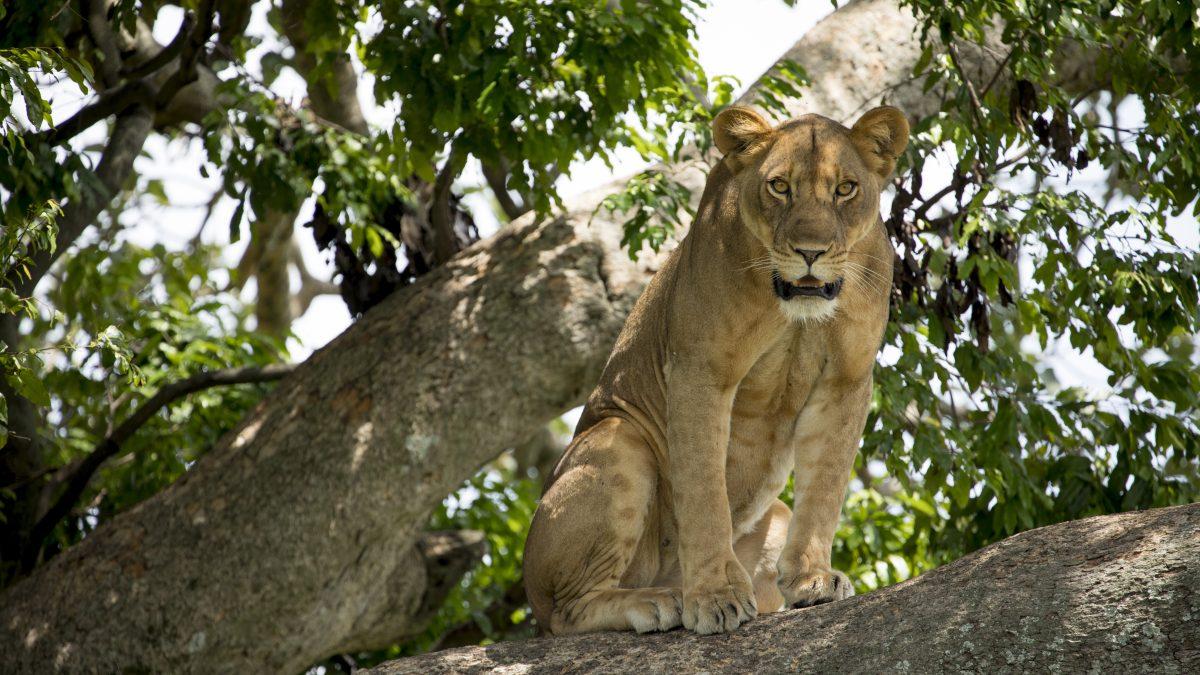
Uganda is one of the few countries in Africa left with lions . African lions (Panthera leo) are the largest and most imposing carnivore in Africa. Lions are among the most sort animals to see during your safari. Their reputation as Kings of the jungle proceeds them and they are among the Big five animals. Uganda with all its offerings as a tourist destination has a number of prides of lions. When you are on safari in Uganda, we can pretty much guarantee that you will see at least one lion. If you know where to look and in a company of an experienced guide.
In Uganda, they enjoy a reputation as ‘king of the beasts’ and are popular symbols of royalty, strength and bravery.
Lions adhere to strict social structures, they live in prides of around 15 individuals. Groups consist of related females and their cubs, who are often born around the same time and raised communally. However new mothers will live in dens with their cubs for the first few weeks. They move them one by one to a new den and every few days to avoid building up a scent that would attract predators. A new male taking over a pride will often kill all cubs, and mate with each of the females.
The male’s distinctive mane plays a role in making it look much larger and more intimidating to other lions and spotted hyenas – the lion’s main rivals. It is the lionesses who are responsible for around 90% of the hunting. They do so in coordinated groups which can allow them to pursue larger species such as buffalo and giraffes as well as smaller antelope. The prey is not evenly shared however only the larger prey is brought back to the pride. Which makes survival difficult for cubs during times of hardship.
Lions can be found in the following places;
Murchison falls National Park
Lions are found in the northern sector of Murchison Falls National Park which is easily be accessable. The savannah grasslands provide a beautiful backdrop for a lion habitat. Murchison falls national park has the magnificent Murchison falls as its center piece which makes the place simply beautiful.
128 individuals have been identified on the northern bank to date. A 2013 census of lions and hyenas in the savannah of the southern bank. Previously under-sampled, revealed the possibility of the south harboring more lions and hyenas. There are indications that the lion population may not be as small now as it was in the 2009 census.
The snare removal exercises need to continue as more than 80% of the snare zone has yet to be surveyed. In order to do this, WCS and UWA need more resources to pay for the basic supplies. The removal team requires in order to conduct frequent snare removal exercises of the entire wire snare zone. Continued monitoring of the lion population is vital. In order to understand the severity of these threats and their impact on the population.
Queen Elizabeth National Park
Queen Elizabeth National Park is a lion conservation unit and hence lions are a key attraction in the park. The park has over 250 of the large cats in both the northern and southern sector. The park is one of the best places to encounter lions in Africa.
Lion monitoring: In 2005, WCS launched a lion project in the Ishasha sector of QENP to monitor lion population dynamics. This population has been ascertained and varies between 20-35 individuals only. WCS discovered that lions in the Ishasha sector move easily between Uganda and the Democratic Republic of Congo. When dispersing and that males have come from the DRC to Uganda to take over prides in Ishasha.
Similarly our research shows that lions migrate from the central sector of QENP to Ishasha through the Maramagambo Forest. This migration is critical to the maintenance of a viable population of lions in Ishasha and if Uganda’s famous tree-climbing lions are to survive we need to maintain this connectivity.

Spoting tree climbing lions during a game drive in Ishasha is considered one of the highlights of a safari in Queen Elizabeth National Park. An activity that is even more interesting is open to tourists interested in an experiential activity – lion tracking. Queen Elizabeth is the only national park in Uganda that offers lion tracking as an activity. The activity is only open at the northern sector (Kasenyi plains) of Queen Elizabeth National Park. Lion tracking is one of the top things to do in Uganda. This offers tourists an opportunity to get close to the lions in their natural habitat unlike standard game drives.
Kidepo Valley National Park
This national park is located in the north eastern corner of Uganda. It is very remote however is worth a visit. It is a beautiful place and the tourist traffic is very minimal due to difficult accessibility. if you make it there you will enjoy the wilderness without so many crowds around. This Park is the perfect place to visit if you are looking for some sense of solitude.
Kidepo Valley National Park boasts of a steadily growing lion population of approximately 132 individual lions that roam the expanses of the vast remote safari Park. The park in our opinion is the best place to see lions in Uganda.
Threats to the lion Population
The biggest threat to lions in Uganda and other parts of Africa is man. Mostly pastoralists and villages that encroach of on lion habitats. These people hunt and kill them because they are dangerous predators. The pastoralists poach the lions to protect their cattle and themselves, and the villages to protect their human population.
Visit Kidepo valley national park, Queen Elizabeth national park, and Murchison falls national park and see the magnificent kings of the jungle on your next Uganda safari trip.



